|
|
Post by sebbe67 on Feb 5, 2005 9:38:47 GMT
LAYSAN RAIL
Formerly Endemic to Laysan Island with an introduced population on Midway and an unsuccessful attempt at introduction to Pearl and Hermes Reef.
Last seen in 1944 on Eastern Island Midway.
Very small sized and flightless but extremely fast on the ground. Adults were brown above with black steaks. Underparts were gray on the breast and head with the crown like the back and the lower belly and undertail chestnut with white and black bars. Eye red. legs greeny. Bill yellow. Food items included insects and birds eggs. Finally succumbed to introduced rat predation and total eradication of vegetation by introduced rabbits. Calls: Frequently called in chorus at night with a pinging, rattling and warbling quality. (6 inches)
In 1828 there were an estimated 2000 individuals on Laysan but only two survived by 1912. By 1936 there were none. Birds which had been relocated to Eastern Island (Midway) in 1891 and 1913 still survived at the start of World War II, as did a few released on Sand Island Midway. Individuals released on Lisianski had succumbed to the depletion of the vegetation and predation by rats like those individuals on Laysan. In 1943 a US Navy landing-craft drifted ashore and accidentally brought with it an invasion of rats to both Islands. By 1945 the Laysan Rail was extinct.
Rather ironically the rabbits were eradicated on Laysan and by 1945 the habitat was almost fully restored - by then however it was too late, the Laysan Rail had disappeared into oblivion forever. The photograph here shows a Laysan Rail taken by Alfred M. Bailey in 1913. (Denver History Photo Archives. All rights reserved
|
|
Deleted
Deleted Member
Posts: 0
|
Post by Deleted on Feb 5, 2005 14:56:39 GMT
Hello !
Russian whalers reportet similar birds from the Kure-Atoll or the lisianski-islands (?) in the 19. century (?).
May have been the same rail-species or a nother one. Who knows ?
|
|
|
|
Post by sebbe67 on Feb 5, 2005 16:52:21 GMT
Yes maybe it is. Its hard to say if it the same species.
|
|
|
|
Post by Melanie on May 31, 2005 0:42:37 GMT
a pic  |
|
|
|
Post by Melanie on May 31, 2005 0:47:04 GMT
LAYSAN RAIL (Porzana palmeri) Ex Formerly Endemic to Laysan Island with an introduced population on Midway and an unsuccessful attempt at introduction to Pearl and Hermes Reef. Last seen in 1944 on Eastern Island Midway. Very small sized and flightless but extremely fast on the ground. Adults were brown above with black steaks. Underparts were gray on the breast and head with the crown like the back and the lower belly and undertail chestnut with white and black bars. Eye red. legs greeny. Bill yellow. Food items included insects and birds eggs. Finally succumbed to introduced rat predation and total eradication of vegetation by introduced rabbits. (6 inches) In 1828 there were an estimated 2000 individuals on Laysan but only two survived by 1912. By 1936 there were none. Birds which had been relocated to Eastern Island (Midway) in 1891 and 1913 still survived at the start of World War II, as did a few released on Sand Island Midway. Individuals released on Lisianski had succumbed to the depletion of the vegetation and predation by rats like those individuals on Laysan. In 1943 a US Navy landing-craft drifted ashore and accidentally brought with it an invasion of rats to both Islands. By 1945 the Laysan Rail was extinct.  Rather ironically the rabbits were eradicated on Laysan and by 1945 the habitat was almost fully restored - by then however it was too late, the Laysan Rail had disappeared into oblivion forever.  The photograph here shows a Laysan Rail taken by Alfred M. Bailey in 1913. (Denver History Photo Archives. All rights reserved). Calls: Frequently called in chorus at night with a pinging, rattling and warbling quality |
|
|
|
Post by another specialist on Jun 8, 2005 11:12:07 GMT
Family/Sub-family RALLIDAE Species name author (Frohawk, 1892) Taxonomic source(s) AOU checklist (1998 + supplements), Sibley and Monroe (1990, 1993) Summary Porzana palmeri was found in grass tussocks and thickets on Laysan Island, Hawai'i, USA, from where it became extinct between 1923 and 1936 as a result of habitat destruction by rabbits and guinea pigs introduced by guano diggers. A similar bird was also seen by Kittlitz on nearby Lisianski Island. Birds were introduced to Pearl and Hermes Reef and to Eastern Island in the Midway Atoll in 1891 and 1913, and from there to Sand Island in 1910, with failed re-introductions also reportedly attempted to Lisianski, Laysan and to the main Hawaiian group. However, the Pearl and Hermes Reef colony was destroyed by storms in 1930, and rats, brought in by wartime activities, exterminated the Sand Island colony in 1943 and the Eastern Island colony in 1944. www.birdlife.net/datazone/search/species_search.html?action=SpcHTMDetails.asp&sid=2902&m=0 |
|
|
|
Post by another specialist on Jun 8, 2005 11:13:23 GMT
|
|
|
|
Post by sebbe67 on Oct 25, 2005 21:55:58 GMT
The Laysan Rail was a tiny inhabitant of the North West Hawaiian atoll of Laysan. This small island was and still is an important seabird colony, and sustained a number of endemic species, including the rail. It became extinct due to habitat loss, feral rats, and the Second World War.
Habitat and Description
Laysan is considered on of the most important seabird colonies in the United States. It has thousands of Black-footed Albatross, Laysan Albatross as well as shearwaters and terns. The island also held 5 unique landbirds, including the Laysan Rail. It was a small (15 cm) bird, flightless member of the rail family, an opportunist that would feed on invertebrates and the eggs of seabirds. It was an aggressive feeder that would fight off other species, particularly the Laysan Finch. It was endemic to the Laysan, though some authors have noted that there were records on other Hawaiian islands.
Extinction
The Extinction of the Laysan Rail is particularly unfortunate as it could have easily been avoided. The Rail was initially threatened when rabbits were introduced to Laysan. With no predators to control their numbers the rabbits soon ate the entire vegetation cover on the island. This turned the island into a barren dust bowl, sending the Laysan Millerbird and the Laysan Honeycreeper (both subspecies endemic to the island) to extinction. The Laysan Finch and Laysan Duck both survived by eating shore flies and scavenging bird eggs and carrion. The Rail is believed to have become extinct on Laysan in the 1920s. The story did not end there, however. The Rail had been introduced to Midway Atoll in 1891, and had thrived on the island. Once the Rail had become extinct on Laysan moves were made to both re-introduce the Rail to its old home and take some to the main islands of Hawaii, along With Laysan Finches, to form a experimental population. This would have safeguarded the species. Rails were collected for this, however the idea was held up by red-tape, some people in the United States Biological Survey were concerned that the Laysan Finch, if it escaped on the main islands, would become a serious pest. The move of some of the birds to safety was therefore held up because of concerns about the finch. The population on Midway survived until the Second World War, when in 1943 a landing craft accidentally broke free during a battle and rats were introduced on to the island. Within two years the species was extinct. A final irony was that the last man to see a Laysan Rail alive was warden Ed Caum, the man who had refused their export to Honolulu. The scientific name honours Henry Palmer, who collected in the Hawaiian Islands for Walter Rothschild.
|
|
|
|
Post by another specialist on Oct 26, 2005 4:07:41 GMT
|
|
Deleted
Deleted Member
Posts: 0
|
Post by Deleted on Nov 1, 2005 17:34:35 GMT
Hi ! Laysan Rail:  Bye Alex |
|
|
|
Post by another specialist on Nov 2, 2005 17:02:45 GMT
|
|
|
|
Post by another specialist on Nov 7, 2005 6:56:37 GMT
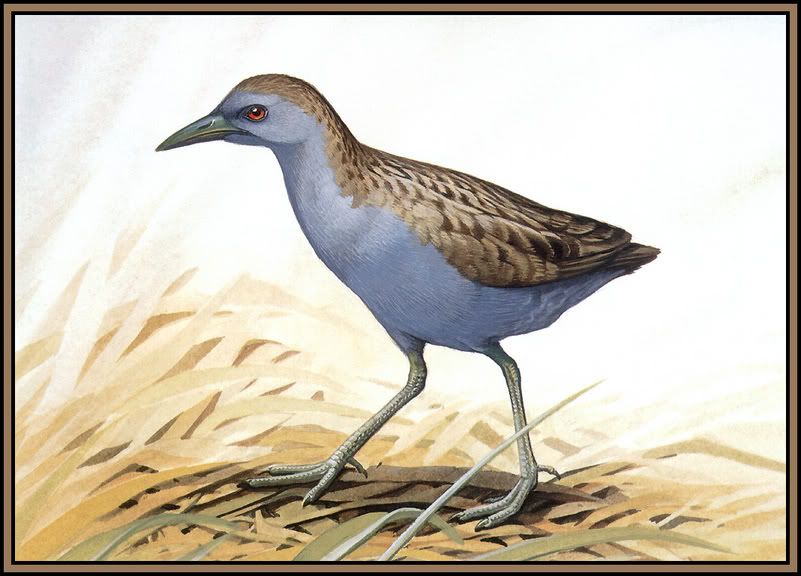 gap in nature |
|
|
|
Post by Melanie on Nov 30, 2005 14:43:50 GMT
|
|
|
|
Post by another specialist on Dec 1, 2005 9:09:40 GMT
the above image is just a larger image of a previous pic in an entry further up
|
|
|
|
Post by sebbe67 on Dec 18, 2005 0:20:37 GMT
Laysan Rail The other extinct rail from the Hawaiian archipelago lived on the remote island of Laysan, where it was quite plentiful. This small Laysan rail Porzanula palmeri ( Frohawk, 1892) was seldom disturbed by humans and was anything but shy. They even entered buildings in search of food. The introduction of guinea pigs and rabbits on Laysan proved fatal to the bird. These animals almost completely destroyed the species' habitat and the Laysan Rail had disappeared from the island by 1936. Some birds had been relocated to Eastern Island in the Midway Atoll. Here they seemed to flourish, until rats from a US Navy landingcraft invaded the island in 1943. Two years later the Laysan Rail was extinct. It is somewhat ironical, that at that time the original habitat on Laysan had just been restored. As it turned out, too late. www.naturalis.nl/300pearls/ |
|
|
|
Post by another specialist on Dec 22, 2005 18:59:23 GMT
from above source  |
|
Deleted
Deleted Member
Posts: 0
|
Post by Deleted on Jun 3, 2007 10:58:42 GMT
|
|
|
|
Post by another specialist on Jun 3, 2007 13:18:52 GMT
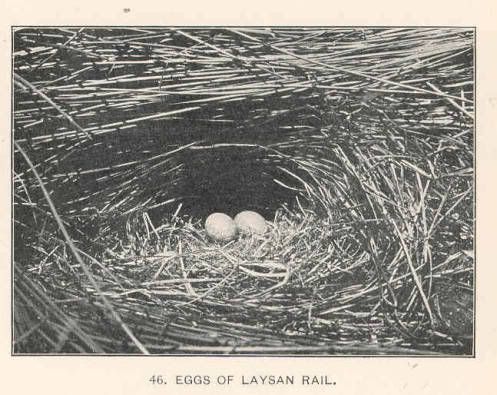 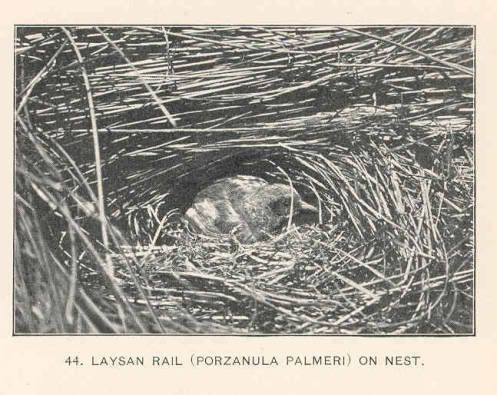 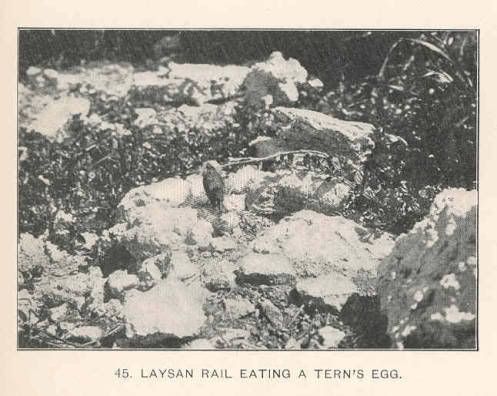 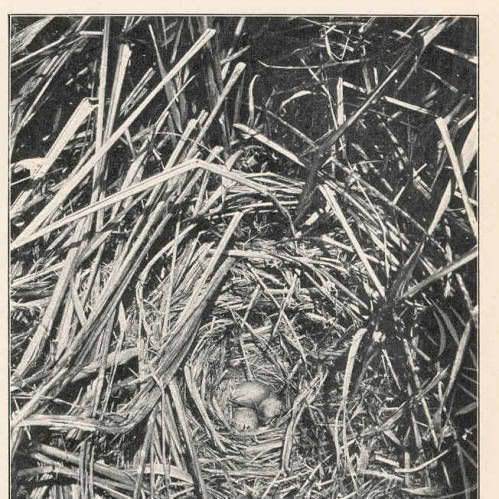 Repository Most materials are located in the University of Washington Libraries. Images were scanned by staff of the UW Fisheries-Oceanography Library Copyright Materials in the Freshwater and Marine Image Bank are in the public domain. No copyright permissions are needed. Acknowledgement of the Freshwater and Marine Image Bank as a source for borrowed images is requested. Ordering Information The University of Washington Libraries does not provide reproductions of this image. This record contains a citation for this image. If you want to use the scanned image, acknowledgement of the Freshwater and Marine Image Bank as a source for borrowed images is requested. For further information contact: fishlib@u.washington.edu. |
|
|
|
Post by another specialist on Jul 28, 2007 9:35:52 GMT
 Storrs L. Olson & Helen F. James, Descriptions of thirty-two new species of birds from the Hawaiian Islands: Part I. Non-Passeriformes Ornithological Monographs 45 (1991) The American Ornithologists' Union, Washington D.C. elibrary.unm.edu/sora/om/om045.pdf |
|
|
|
Post by another specialist on Jul 28, 2007 9:37:40 GMT
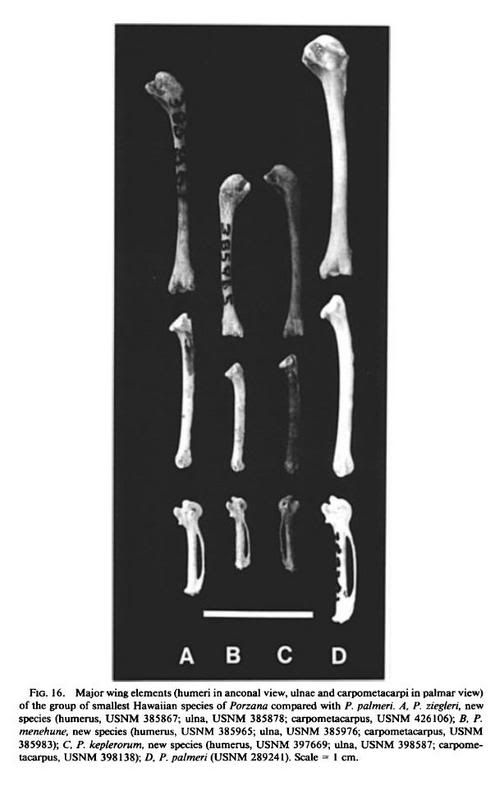 Storrs L. Olson & Helen F. James, Descriptions of thirty-two new species of birds from the Hawaiian Islands: Part I. Non-Passeriformes Ornithological Monographs 45 (1991) The American Ornithologists' Union, Washington D.C. elibrary.unm.edu/sora/om/om045.pdf |
|























